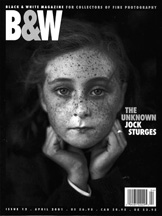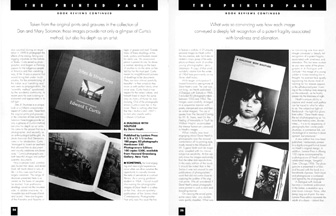



A Dialogue With Solitude
by Leland Rice
Black and White Magazine, April 2001
by Leland Rice
Black and White Magazine, April 2001
Sometimes, the most engaging and meaningful experiences occur when we allow ourselves the opportunity to casually browse the racks of periodicals in a school library. As a young graduate student in 1964, I found myself discovering the photographic imagery of Dave Heath in a rather, at the time, obscure quarterly publication of the sixties titled Contemporary Photographer. Not only was this issue the first to feature a portfolio of 21 uniquely personal images by Heath within the documentary style, but it also included a major group of the early photo-synthesis work of another young photographer, Jerry Uelsmann. A copy of that small, wonderful volume from the winter of 1964 lives prominently on my library shelf today.
With eager anticipation I looked forward to seeing more of Dave Heath's work. The wait was not long, as Heath published A Dialogue with Solitude in 1965. It included 82 photographs taken between 1952 and 1962. The images were carefully arranged in a sequential manner with poetry interspersed now and then as verbal imagery. The use of quotes from The Second Coming by W. B. Yeats, and On the Feeling of Immortality in Youth by William Hazlitt, accentuated the intense humanism conveyed in Heath's images.
What initially was most engaging about Dave Heath's photographs was the unusual combination of his printing style, mostly traced to the influence of W. Eugene Smith and Life magazine, coupled with his intense subjective sensibility. At first we only knew his images exclusively from the rather dark reproductions in the early edition of this book. It should be noted that in the sixties it was not unusual to see publications of photographers' work that did not come close to capturing the qualities of the original prints. We all wondered if Dave Heath's actual photographs were printed in such a dark and brooding manner.
On viewing the actual prints some years later, any doubts were quickly dispelled. What was so convincing was how each image conveyed a deeply felt recognition of a potent fragility associated with loneliness and alienation. This becomes evident as you view some of the photographs in A Dialogue with Solitude - the image of a young soldier in Korea standing lost in thought, his scarred face quietly registering the divine ritual of waiting for his release papers; or the self-absorbed priest, frowning at the curled-up man sleeping on the sidewalk, as he hastily passes into the blackness of night.
Heath's unique ability to capture and reveal such pathos can be traced to what he refers to as "the subjective light of Rembrandt - the light that glows from within." Dave Heath views the act of photographing as "no more than making notes, diaristic notes ... It is in my sequencing of photographs that I create poetic structures, a connective link, not chronological or narrative in development, but emotional."
A new edition has now been published, handsomely printed in a slightly enlarged format, based on Heath's original design. In addition, Lumiere Press is offering 100 copies accompanied by a photogravure of Heath's most celebrated image, Vengeful Sister, Chicago, 1956. The photogravure is presented in a folio and housed with the book in a handmade slipcase. Each book and photogravure is numbered and signed by the photographer.
A Dialogue with Solitude became a landmark publication in the sixties, a revelation of a total book concept. Now, after being long out of print, this new Lumiere Press edition represents the rebirth of a classic.